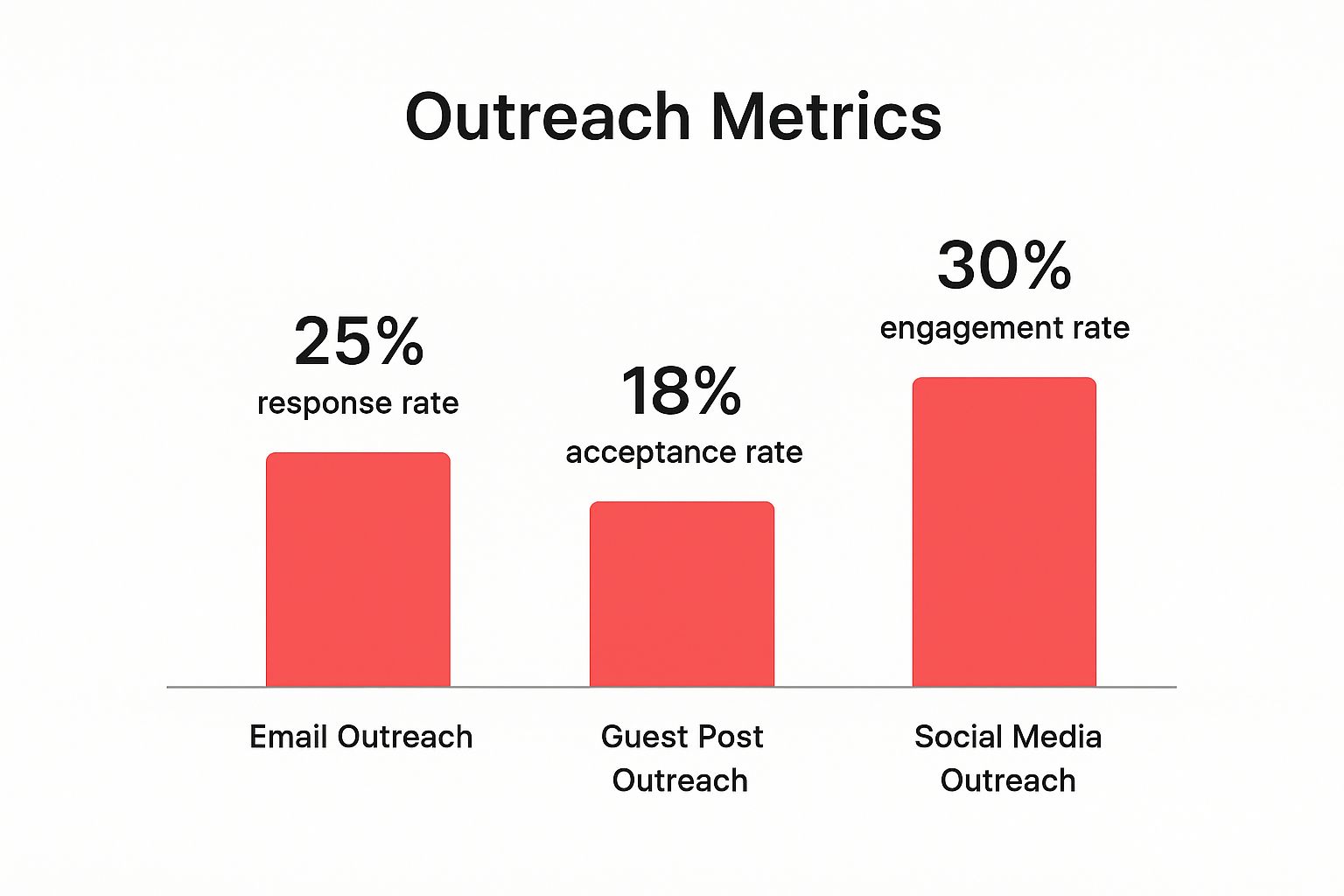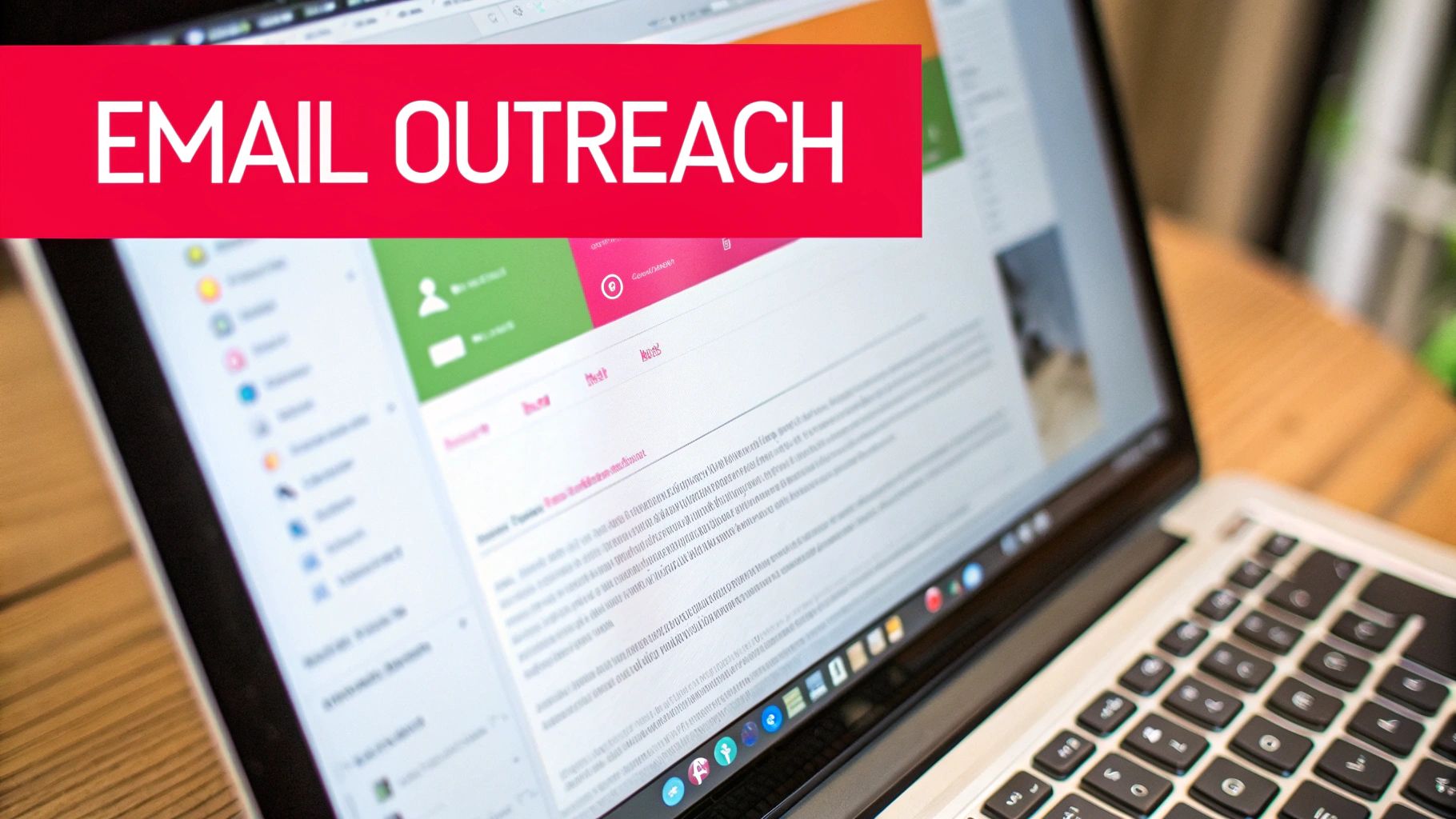Outreach Link Building: Proven Strategies for Success
Master outreach link building with expert tips on prospecting, email personalization, and scaling campaigns to boost your backlinks.

Did you know that over 32% of a typical SEO agency's budget is dedicated solely to link building? This massive investment highlights a core truth: earning high-quality backlinks is non-negotiable for ranking on Google.
Outreach link building is the hands-on approach of connecting with real people—editors, bloggers, and site owners—to earn those powerful, editorially given links.
Why Outreach Is Still King in Link Building
Ever wonder where SEO agencies put their money? A huge chunk of it—over 32% of their entire SEO budget—goes directly into link building.
That’s not a small investment, and it points to a simple fact: outreach isn't just another task on a checklist. It's the foundation for building real website authority and climbing the search rankings.
Unlike automated or spammy tactics, thoughtful outreach lets you build actual connections with people in your industry. This ensures the links you earn come from relevant, trustworthy sources that can send real traffic your way.
This guide will walk you through the strategies that make manual outreach a powerhouse for your SEO. We'll dive into everything from planning and finding the right people to contact, all the way to writing emails that actually get a response.
Laying the Foundation for a Killer Outreach Campaign

Here’s a hard truth: most outreach campaigns are dead on arrival. They fail long before the first email ever gets sent.
Why? Because people get so caught up in the doing—the sending, the following up—that they completely skip the most important part: the strategy.
You have to get this right. We're not just collecting links for the sake of it; the real goal is to earn backlinks that actually move the needle for your business.
So, the first thing you need to ask yourself is, what's the point of this campaign? Your answer here will shape every single decision you make from this point forward.
Nail Down Your Campaign Goals
Without a clear goal, you're just flinging emails into the abyss and hoping something sticks. You need a North Star for your campaign, something specific and measurable.
Here are a few of the most common goals I see:
- Boost Domain Rating (DR): This is a long game focused on getting links from high-authority sites to raise your whole website's tide.
- Rank a Specific Page: Much more targeted, you’re aiming all your firepower at a key service page or a monster blog post.
- Drive Real Referral Traffic: Here, you want links from sites with super-engaged, relevant audiences who will actually click through.
My Two Cents: A winning outreach strategy isn't about getting any link—it's about getting the right one. Tie every ounce of effort back to a real business goal, like boosting page rankings or growing domain authority.
Figure Out Your "Linkable Assets"
A linkable asset is just a fancy term for a piece of content on your website that’s so genuinely useful, interesting, or unique that other people will actually want to link to it.
If you don't have a compelling asset, you're basically asking for a handout. But when you have something truly valuable—like original research or a nifty free tool—the entire dynamic shifts.
Suddenly, you're not begging for a favor. You're offering a resource that makes their content better.
Spy on Your Competitors (Ethically, of Course)
One of the smartest shortcuts in link building is to see what's already working for the competition. Fire up your favorite SEO tool and start digging into their backlink profiles.
I always look for "link gaps"—websites that have linked to two or three of my competitors, but not me. That's a warm introduction waiting to happen.
You can also see which of their content types attract the most links, giving you a proven blueprint for the kind of linkable assets you should be creating. If you're new to this, it's worth brushing up on the core link building best practices that all the pros rely on.
Finding and Vetting High-Quality Link Prospects
Your outreach campaign is only as good as the prospect list you build. Let's be honest, the old "spray and pray" method of mass-emailing hundreds of websites is dead.
A successful outreach link building strategy is all about quality over quantity. The real goal is to build a curated, high-potential list where every single contact represents a genuine opportunity.
Sure, this approach takes more time upfront, but the payoff is huge—we're talking significantly higher response rates. Instead of just chasing vanity metrics, you're building real relationships.

As you can see, social media often drives higher engagement, but don't count email out. It remains a powerhouse for securing actual replies and guest post acceptances.
Uncovering Opportunities with Search Operators
Advanced Google search operators are your secret weapon for finding prospects who are practically raising their hands for content like yours. These allow you to pinpoint specific types of pages that are prime targets for outreach.
For instance, instead of just searching for "marketing blogs," you can get way more specific:
"your keyword" + intitle:"write for us": This is the classic. It finds sites in your niche that have a dedicated page for guest contributors."your keyword" + inurl:"resources": This little gem helps you discover resource pages where your killer linkable asset would be a perfect fit."your keyword" + "guest post by": This uncovers sites that have accepted guest content before, which tells you they're open to collaboration.
Using these operators cuts through all the noise, leaving you with a clean list of websites that are already receptive to the idea of external contributions.
Using SEO Tools for Smarter Prospecting
While search operators are fantastic for manual digging, you'll need modern SEO tools to scale your efforts and analyze prospects efficiently.
The biggest shift recently has been the integration of artificial intelligence into the outreach process. AI-powered tools like Linkyleap are now incredibly good at sifting through massive datasets to identify the most relevant websites.
But here’s the thing: AI isn't a silver bullet. The best results always come from blending its powerful insights with genuine human expertise. To really get ahead, it pays to learn more about how AI is shaping the future of link building strategies.
To give you a better idea of your options, here's a quick look at some common prospecting methods.
Comparing Popular Link Prospecting Methods
| Method | Description | Best For | Tools Required |
|---|---|---|---|
| Manual Google Search | Using advanced search operators to find specific page types like "write for us" or "resources" pages. | Highly targeted, small-scale outreach campaigns where relevance is critical. | Google Search |
| Competitor Backlink Analysis | Analyzing the backlink profiles of your top competitors to find sites linking to them. | Finding proven link opportunities that are already relevant to your industry. | Ahrefs, Semrush, Moz |
| Content-Driven Prospecting | Finding websites that have linked to or shared content similar to yours in the past. | Promoting a specific piece of content, like an infographic, study, or ultimate guide. | SEO Tools, BuzzSumo |
| Automated Prospecting Tools | Using platforms that automatically discover and filter prospects based on your defined criteria. | Scaling outreach efforts and building large, relevant lists quickly. | Linkyleap, Pitchbox, Hunter |
Each method has its place, and the most successful campaigns often use a mix of these approaches to build a robust and diverse prospect list.
The Essential Vetting Framework
Finding a potential prospect is just step one. The vetting process is where you separate the gold from the gravel.
Before adding any site to your outreach list, run it through this quick checklist:
- Check for a Pulse: Does the blog publish content regularly? If a site hasn't been updated in six months, it's probably a ghost town.
- Look for Real Engagement: Are people actually commenting on posts or sharing them? Genuine engagement is a powerful sign of a healthy community.
- Review Their Standards: Is the content well-written, insightful, and professional? You're looking to associate your brand with quality.
Key Takeaway: Whatever you do, never skip the vetting process. I'll take a well-curated list of 50 high-quality, relevant prospects over a generic list of 500 any day of the week.
Crafting Outreach Emails That Actually Get Replies

So, you've put in the work and built a solid prospect list. This is where the rubber meets the road—the email itself.
Think about it: the average person is swimming in a sea of over 120 emails every single day. Your message has to be the one that makes them stop scrolling.
This isn't about finding some magical, one-size-fits-all template. It's about getting inside the head of the person you're emailing and writing something that feels personal, valuable, and genuinely human.
The Anatomy of a Winning Email
Every outreach email that gets a reply shares a few key ingredients. It starts with a subject line that grabs their attention without feeling like clickbait.
Then, your first sentence has to immediately prove you’ve done your research. Finally, your actual request needs to be crystal clear and framed around what they get out of it.
Subject Lines That Get Opened
Your subject line is the gatekeeper. If it’s boring or spammy, the rest of your brilliant email will never even be seen.
Here are a few approaches I’ve seen work time and time again:
- Compliment & Question: "Loved your post on [Topic], quick question"
- Hyper-Specific: "Your article on [Specific Article Title]"
- Mutual Interest: "Idea for your [Blog Name] blog"
Whatever you do, stay away from generic titles like “Link building opportunity” or “Content suggestion.” They’re an instant red flag for a mass email.
Pro Tip: Keep your subject lines short—under 50 characters is the sweet spot. This makes sure nothing gets cut off on mobile devices, which is where most people first check their email.
Personalization Beyond the First Name
Let’s be honest, [First Name] doesn’t count as personalization anymore. Real personalization shows you’ve actually paid attention to their work.
Before you even start writing, find a genuine point of connection:
- A recent blog post: "I really enjoyed your take on how AI is impacting content strategy. The point you made about authenticity was spot on."
- A social media share: "Saw on LinkedIn that you shared an article about customer retention. We just published a deep-dive on that topic."
- A podcast appearance: "Heard you on the [Podcast Name] show last week. Your advice on scaling a team was incredibly insightful."
That one sentence does all the heavy lifting. It instantly separates you from the 95% of generic outreach that floods their inbox.
The Value Proposition is Everything
Once you've made that connection, you have to immediately answer their silent question: "What's in it for me?" So many outreach emails fall flat right here.
If you're doing broken link building, the value is obvious—you’re helping them fix a dead link. If you're pitching a guest post, the value is high-quality content for their audience. For more on this approach, this guide on relationship-based link building is a fantastic read.
Always frame your request around their benefit, not yours. It's a simple shift in perspective that changes everything.
Following Up and Tracking Your Campaign Success

Hitting "send" on that first email is just the opening move. The real magic in outreach link building often happens in the follow-ups.
In fact, it’s not uncommon for 40% or more of your successful links to come from those gentle nudges. This is where so many campaigns fizzle out.
Building a structured follow-up sequence is the secret sauce to turning that initial silence into a conversation. The key is to be persistent without being a pest.
The Art of the Follow-Up
Your follow-up can't just be a lazy "just checking in" message. Each one is a new opportunity to add a little more value or re-engage someone.
I've found a simple, spaced-out sequence works wonders. The most important rule? Keep all your messages in the same email thread.
Here's a framework that consistently gets results:
- Follow-Up 1 (2-3 days later): This is a simple, polite bump. A quick, two-sentence message like, "Hey [Name], just wanted to make sure this didn't get buried," is perfect.
- Follow-Up 2 (4-5 days later): Still no reply? It's time to try a slightly different angle, perhaps mentioning an alternative resource they might like.
- The Break-Up Email (7 days later): This is your final, no-pressure goodbye. A simple note like, "I'm guessing this isn't a priority right now, so I won't follow up again," can actually trigger a response.
Measuring What Truly Matters
Once your emails are going out, you absolutely need a system to track what's working. Meticulous tracking keeps you organized and helps you avoid embarrassing mistakes.
Start by zeroing in on the Key Performance Indicators (KPIs) of the outreach itself. These metrics give you a direct window into the health of your campaign.
Key Takeaway: You can't improve what you don't measure. Diligent tracking transforms outreach from a guessing game into a predictable, scalable process.
These are the foundational metrics that act as your campaign’s pulse:
- Open Rate: The percentage of people who actually opened your email.
- Reply Rate: The percentage who replied, a massive indicator of how well your pitch is landing.
- Link Acquisition Rate: The ultimate success metric—the percentage of outreach that resulted in a live link.
Connecting Links to Business Goals
While outreach metrics are your tactical guide, the real goal is to prove that your link building is moving the needle for the business. You have to connect the dots between that shiny new backlink and tangible business results.
This is where tools like Google Analytics and Ahrefs come in handy. Keep a close eye on the pages you're building links to.
Are you seeing positive trends in organic traffic? Are your target keywords climbing up the SERPs? This is how you demonstrate the true value of your work.
Recent data shows 61% of professionals plan to increase their link building budgets. If you want to dive deeper, you can explore more about these spending trends to see just how critical this strategy has become.
How to Scale Outreach Without Losing Quality
So, your first few campaigns are getting traction. But now you’re staring down a new challenge: how do you ramp up your outreach link building without watering down the quality?
I’ve seen teams hit incredible response rates—as high as 25-30%—and the secret is always in the personalization. The trick to scaling is to maintain that human touch while increasing volume.
This is where you build your link-building 'machine.' It's about creating solid, standardized processes for finding prospects, sending emails, and tracking what works.
Automate the Tedious, Not the Personal
Let’s be clear: scaling isn’t about automating relationships. It’s about automating the repetitive, mind-numbing tasks that eat up your day.
You can offload the stuff that doesn't need a human touch, like:
- Scheduling sends and follow-ups: Set your emails to go out at the perfect time.
- Tracking replies and opens: Instantly see who’s engaging and focus on the warmest leads.
- Managing your prospect list: Keep contacts neat and tidy to avoid cringey mistakes.
Automating these tasks frees you up to do what actually earns links: writing compelling, personalized messages that connect with real people.
Key Insight: Successful scaling comes down to one simple rule—automate the process, not the personality. Let tools handle the workflow, but make sure a human is always steering the part that builds the actual connection.
Building an Efficient Outreach Team
Eventually, you'll hit a ceiling on what you can do alone. Bringing on a small, focused team is the natural next step.
The key is to define roles early to create a smooth workflow. Even if one person wears a few hats at the start, think about breaking down the work:
- Prospector: This person is your treasure hunter, responsible for digging up and qualifying high-value link opportunities.
- Outreach Specialist: They’re the communicator—crafting those personalized emails and nurturing relationships.
- Content Strategist: The brains behind the bait, figuring out what link-worthy content you need.
When everyone knows exactly what they’re responsible for, efficiency and quality both shoot up. This systematic approach is one of the best link building strategies you can implement.
Your Top Link Building Outreach Questions, Answered
Even after years in the trenches, I still see the same questions pop up about outreach link building. The SEO landscape shifts constantly, but the fundamentals haven't changed a bit.
Getting these right will help you focus your energy on what actually moves the needle.
How Many Emails Should I Be Sending Out Each Day?
This is the classic quality vs. quantity dilemma. I always recommend aiming for 10-20 truly personalized emails a day.
You'll get much better results from a small, hand-picked list than from a generic "spray and pray" blast to hundreds. Once you have a system that works, you can think about scaling.
Does Outreach Link Building Actually Still Work?
Without a doubt. In many ways, it's more important now than ever before.
Getting high-quality backlinks from relevant and authoritative websites is still one of the biggest signals Google looks at. Smart outreach is the only truly sustainable way to earn these powerful links and is a key part of the approach we cover in our guide to white hat SEO tactics.
A solid, personalized outreach campaign should be pulling in a response rate somewhere between 5% and 10%. If you're hitting that benchmark consistently, you're doing great.
So, What's a Good Response Rate to Aim For?
If you're hitting that 5-10% benchmark, you're on the right track. Anything higher is cause for celebration.
On the flip side, if your response rate is dipping below 3%, that's a red flag. It's a clear sign that you need to pump the brakes and figure out what’s broken in your process.
How Long Until I See Any Real Results?
Link building is definitely a marathon, not a sprint. You might land a few good links in the first few weeks, but you should expect it to take 3 to 6 months to see a real lift in your organic search rankings.
Consistency is everything here. Think of every link you build as a long-term asset that adds permanent value to your site's authority.
Ready to scale your link building without the endless cold emails? Linkyleap connects you with thousands of verified websites in your niche, making it simple to build high-quality backlink partnerships. Stop guessing and start growing at Linkyleap.


